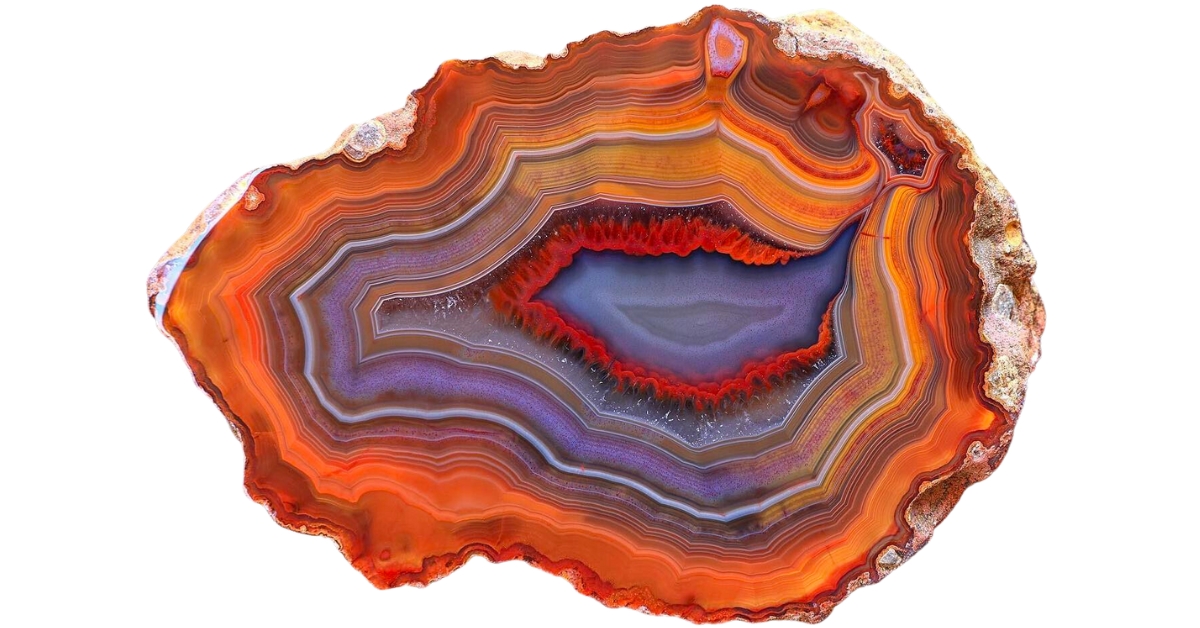Agate is a colorful, eye-catching type of rock that forms when silica from groundwater fills in cavities and cracks in other rocks. This process happens over millions of years, layer by layer, giving it its one-of-a-kind, beautiful bands.
So, what does agate look like? Imagine stripes and bands of different colors, like layers of a cake, but much harder! These layers can be all sorts of colors: red, blue, green, yellow, and more. Each piece of agate is like a one-of-a-kind painting.
In this article, we’ll explore the different types of agates and how uniquely beautiful each of them is. You’ll be amazed at the wide variety of this natural wonder and even the vastness of its patterns and banding.
Remember, no two pieces of agates are exactly alike. So, get ready to be mesmerized by the photos of the vast agate types here. Let’s get started!
The 22 Different Types Of Agate And What They Look Like
Agates are not just pretty— they hold great value for collectors, artists, and anyone who loves natural wonders. The value of agate represents millions of years of Earth’s history, locked in vibrant colors and patterns.
When we explore its types, we discover a world of natural art, with each type offering a unique glimpse into the incredible processes that shaped our planet.
Blue Lace Agate
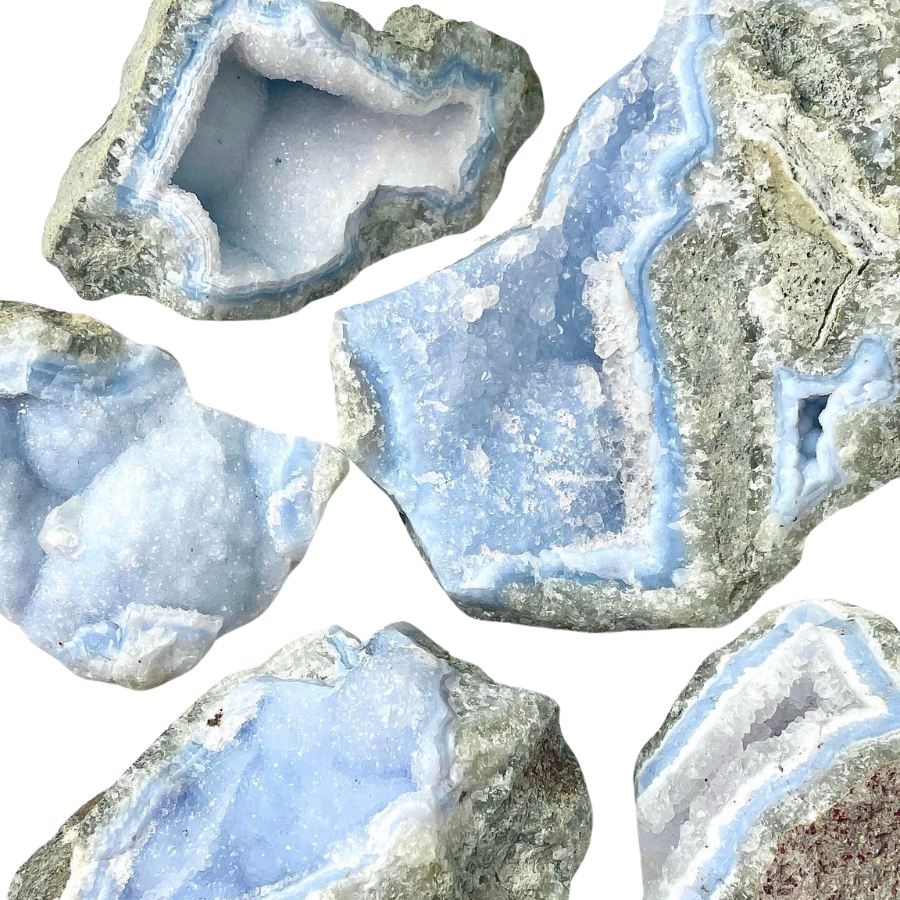
Blue lace agate is like the soft, sky-blue waves with lines that swirl and twist like delicate lace.
Its pattern comes from slow-forming layers of quartz, which create those beautiful, lace-like bands.
The bands of this agate type are often in shades of light blue, white, and sometimes a bit of grey. It’s different from other agates, which usually have more intense colors and stronger patterns.
The value of blue lace agate lies in its soft, tranquil look and the feeling of calm it brings. It’s often used in jewelry or as a decorative stone.
Where you can find blue lace agate
If you’re wondering where to find agates, particularly this type, blue lace agate is mainly discovered in places that have a lot of volcanic activity. It forms in the cracks and cavities of the rocks that are affected by this volcanic action.
These locations are often remote and can be quite rugged. Among them are Namibia, in Africa, and Brazil. Another interesting location is the USA, especially in Oregon and Idaho.
Moss Agate
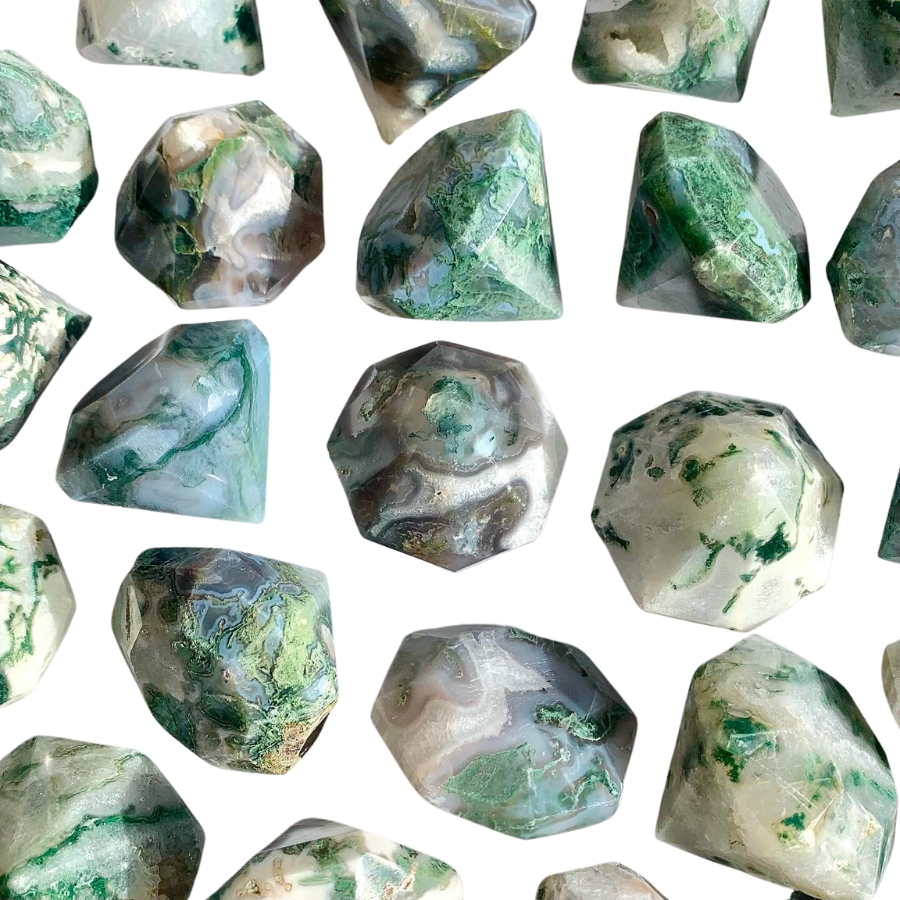
Instead of having the typical banding for which the different types of agates are known, moss agate has green inclusions that look like moss or trees.
These green patterns aren’t real plant material, though. They’re minerals like chlorite or iron oxide.
In some cultures, this type of agate is known as the “gardener’s stone” because of its green, plant-like appearance. It’s believed to help plants grow.
The price of moss agate can vary. It’s often quite affordable, but the more distinct and picturesque the green patterns, the more it might cost.
Where you can find moss agate
You can find moss agate in environments where volcanic rocks are present. In the USA, Montana, Wyoming, and South Dakota are known for having them.
India is another country where it’s commonly found. The regions in this country that have moss agate often reveal pieces with exceptionally vivid green patterns.
In these locations, you’re likely to find moss agate in riverbeds or along the edges of volcanic fields. If you need more information on the best rockhounding locations, check out our article.
Fire Agate
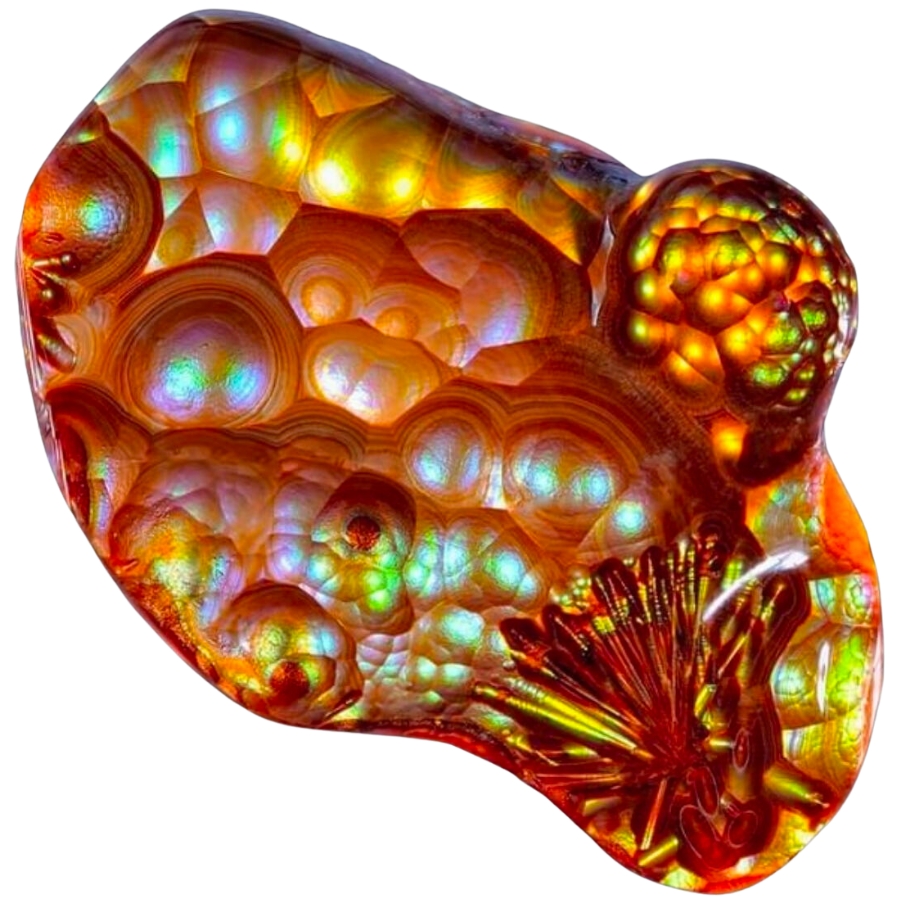
Fire agate is known for its incredible colors and the way it sparkles like fire. It’s got layers of silica and iron oxide that reflect light, creating a fiery effect.
When you look at fire agate, it’s like seeing flames trapped inside. Its colors can range from reds and oranges to greens and golds, all shimmering under the surface.
You might be wondering, “What is fire agate worth?” Well, its value comes from its rare beauty. The more color and sparkle, the more valuable the stone is.
Its fiery iridescence and lively play of color are used in jewelry pieces that are meant to stand out.
Where you can find fire agate
Fire agate grows in volcanic regions. It develops in the cavities of volcanic rocks, where silica-rich water has flowed through.
You’ll find it mainly in the southwest states of the USA, like Arizona, California, and New Mexico. Need help on how to find crystals? Check this out.
Mexico is another country where you can find fire agate. Just like in the American Southwest, the volcanic areas in Mexico provide the ideal environment for its formation.
Dendritic Agate
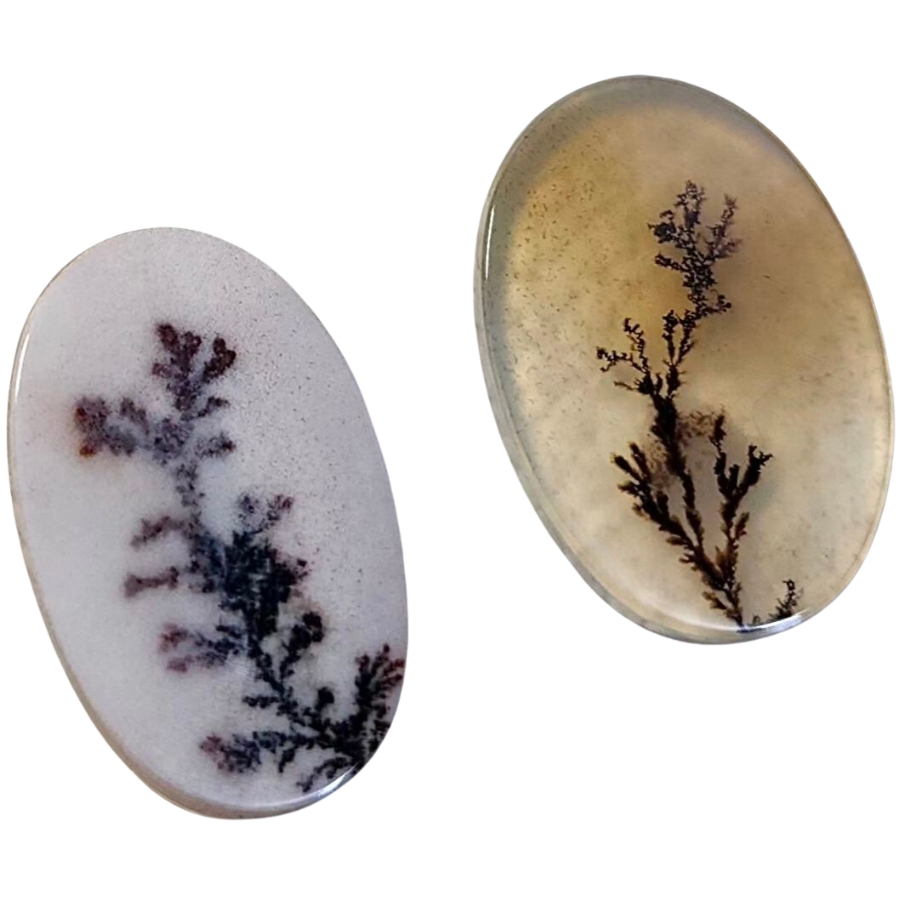
Dendritic agate is known for patterns that look like tiny trees or shrubs. Like moss agate, these patterns aren’t actual plants. They’re made of minerals, mostly manganese or iron oxides.
When you look at a dendritic agate, it’s like peering into a miniature forest or a frosty winter landscape.
The base of the stone is usually translucent to opaque, and the “dendrites”— those tree-like patterns— are often black or brown.
When it comes to how much dendritic agate is worth, it can vary. The more detailed and distinct the patterns are, the more it’s usually valued.
In some cultures, dendritic agate is believed to bring fullness and richness to life.
Where you can find dendritic agate
If you want to find dendritic agate, you’re in luck because it naturally occurs in the USA, particularly in Montana and Wyoming. And if you need help finding gem mines near you, you can refer to our guide.
India and Brazil are also known for having beautiful dendritic agates. The conditions there are just right for creating the intricate, tree-like patterns of this agate.
Crazy Lace Agate
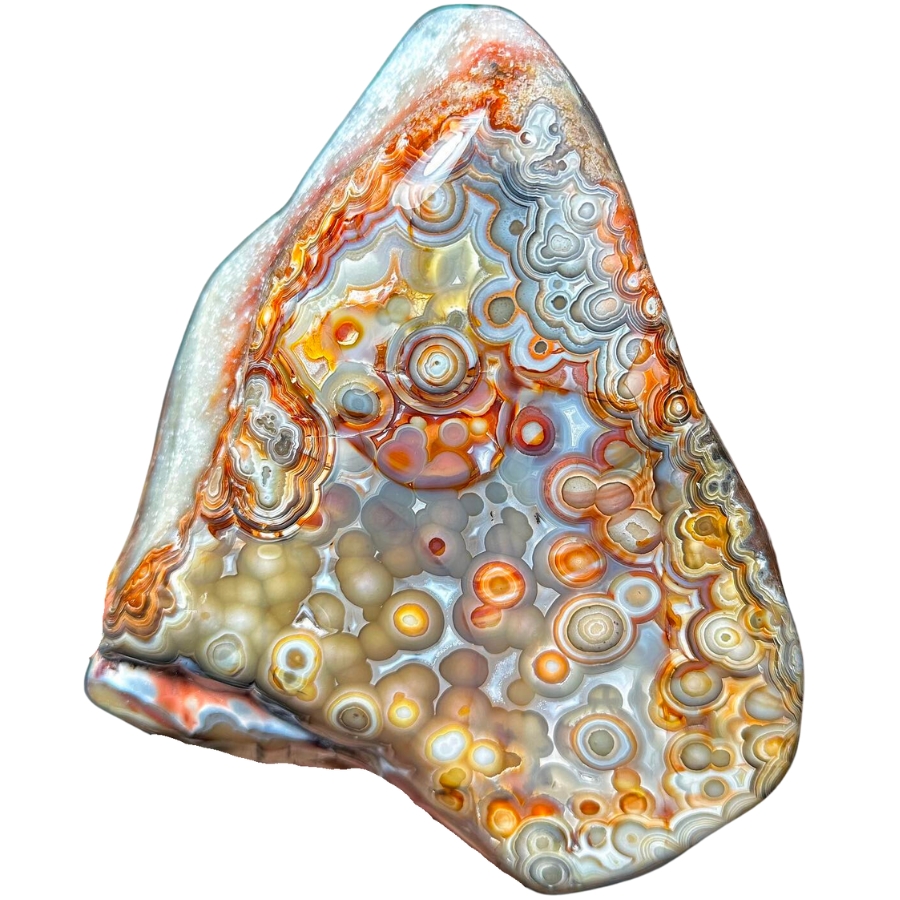
Crazy lace agate is like a party in a rock! It’s got swirls, circles, and all sorts of wild patterns dancing across it.
Its colors can be a mix of red, orange, yellow, and brown, and sometimes even a bit of gray or white.
What makes crazy lace agate stand out is its vibrant and complex patterns. No two pieces are the same. This distinctiveness is a big reason why it’s so valued.
Despite its wild and ‘crazy’ appearance, it’s sometimes called the “Laughter Stone” or “Happy Lace” because of the joy and positive vibes it’s believed to bring.
Where you can find crazy lace agate
One of the most famous places where you can find crazy lace agate is Chihuahua, in Northern Mexico. It’s known for producing some of the most colorful and intricate finds.
Unfortunately, you won’t find crazy lace agate just anywhere in the USA, but there are similar types of banded agates in Arizona and Oregon.
Botswana Agate
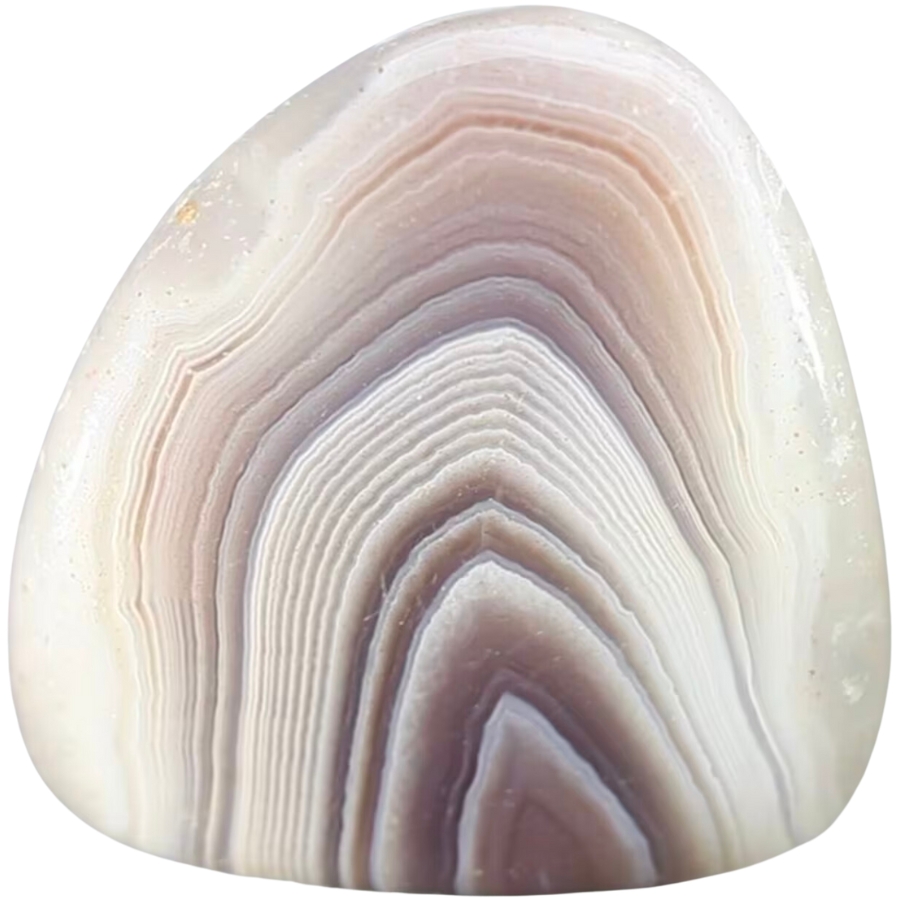
Botswana agate is famous for its striking patterns and warm colors. It has bands of pink, brown, gray, and sometimes even blue or purple swirling around each other. These bands can be wide or thin, straight or wavy.
This type of agate stands out because of its fine banding and its warm, comforting colors. It’s often used in jewelry, where its natural beauty can really shine.
People value it not just for its looks but also for its believed healing properties. It’s thought to help with things like stress and decision-making.
It’s sometimes called the “Sunset Stone” because its colors can look like the sky at sunset.
Where you can find Botswana agate
Botswana agate gets its name from the country where it’s most famously found: Botswana, in Africa. The areas where Botswana agate is found are usually in the regions that were affected by volcanic activity a long time ago.
Unfortunately, this type of agate is not commonly found in the USA.
Laguna Agate
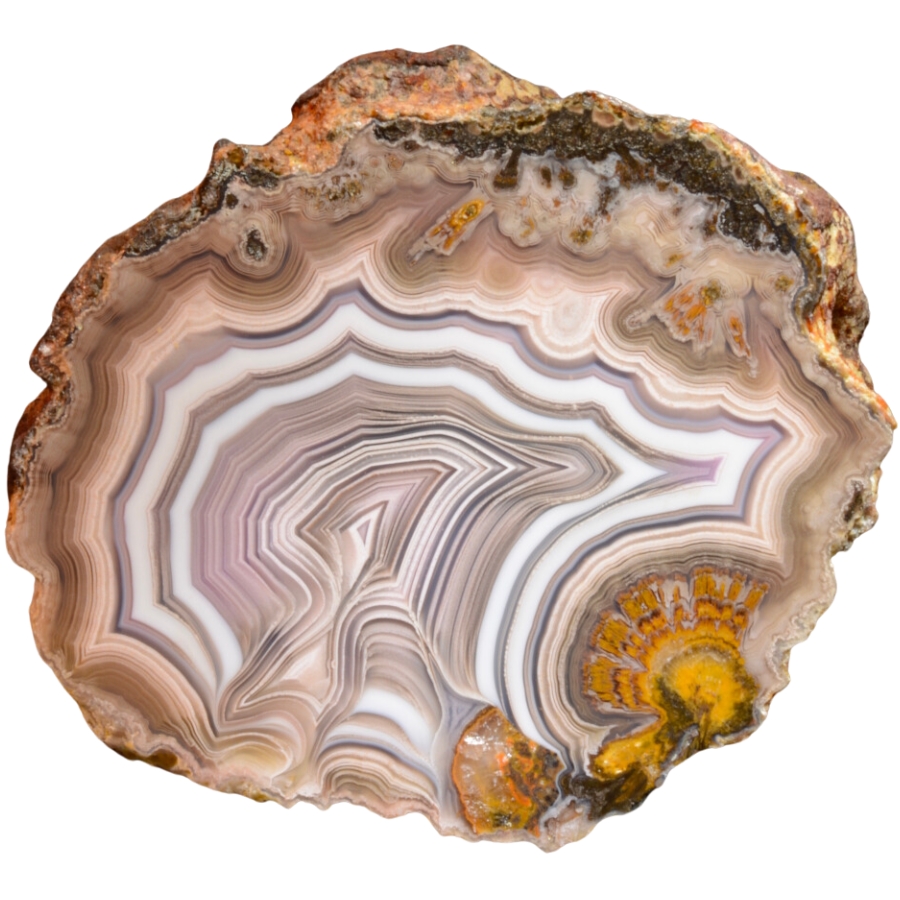
Laguna agate has incredibly sharp and fine banding. It has layers of red, orange, pink, yellow, and sometimes even purple and white all stacked in neat, tight bands.
These bands can form eye-catching patterns, like swirls, loops, and even landscapes.
The different colors of its bands come from various minerals present in the water at the time of its formation.
Laguna agate is considered one of the finest agates in the world due to its exceptional banding. This high regard among agate varieties makes it a prized possession for collectors.
Where you can find Laguna agate
Laguna agate is primarily found in one world-famous place: the state of Chihuahua in northern Mexico. Its unique geological history, involving ancient volcanic activity, is what makes it the perfect spot for these agates to form.
Unfortunately, Laguna agate does not form and occur naturally in the USA.
Condor Agate
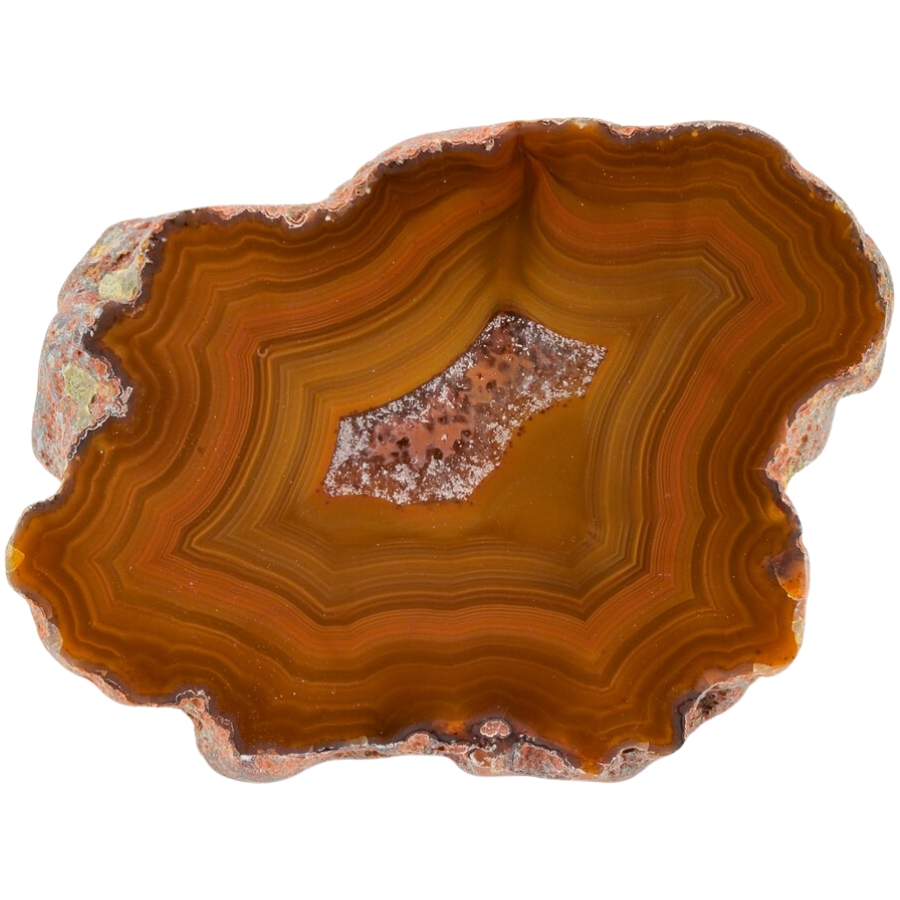
Condor agate is a real standout. It’s known for its bright, vivid colors and complex patterns.
It has reds, oranges, yellows, and sometimes even blues and greens all swirling together. These colors form in bands or in more random, artistic patterns.
The intensity and variety of its colors is what makes condor agate so special. It’s often used by artists and craftsmen who want to make a statement with their work.
Condor agate’s bold colors and patterns can turn a simple piece of jewelry or art into something really eye-catching.
Where you can find condor agate
Condor agate is mostly found in Argentina. This South American country, particularly the Patagonia region, has the perfect conditions for creating this agate.
The places where condor agate grow are usually where volcanic activity happened long ago. It forms in the cavities of these volcanic rocks.
Fortification Agate (Banded Agate)
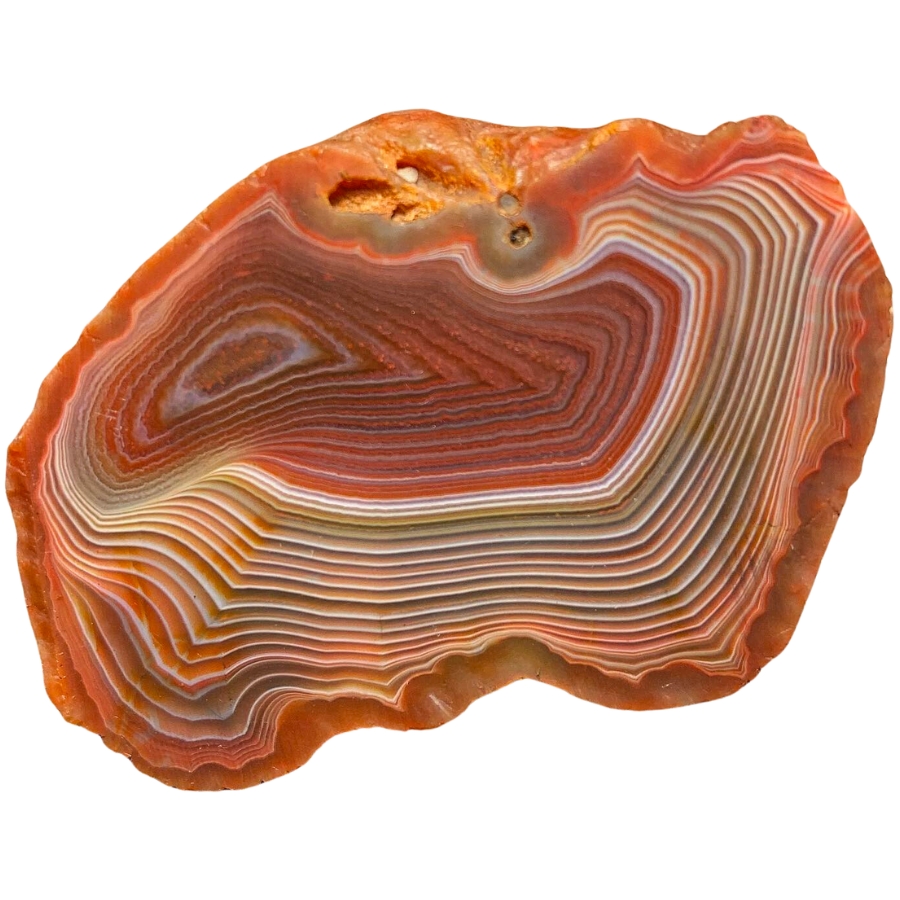
Fortification agate gets its name because the patterns inside it look like the aerial view of a fortified city.
Imagine seeing bands of color forming shapes that look like walls, with sharp angles and curves. They are usually in different colors, making each layer stand out.
If fortification agate is valuable, it’s because of its distinct patterns and colors. Its unique look makes it sought after for jewelry and as a collector’s item.
The clearer and more defined the patterns, the more valuable the stone can be. Some people also believe it can help with relaxation and calmness.
Where you can find fortification agate (banded agate)
You can find fortification agate in Arizona, Texas, and Oregon in the USA. These states have the right kind of rocks and geological past for this agate to form.
Other countries like Brazil and Uruguay also have amazing fortification agates. What’s exciting about finding this agate in these places is that each location gives the stones a slightly different look.
Iris Agate
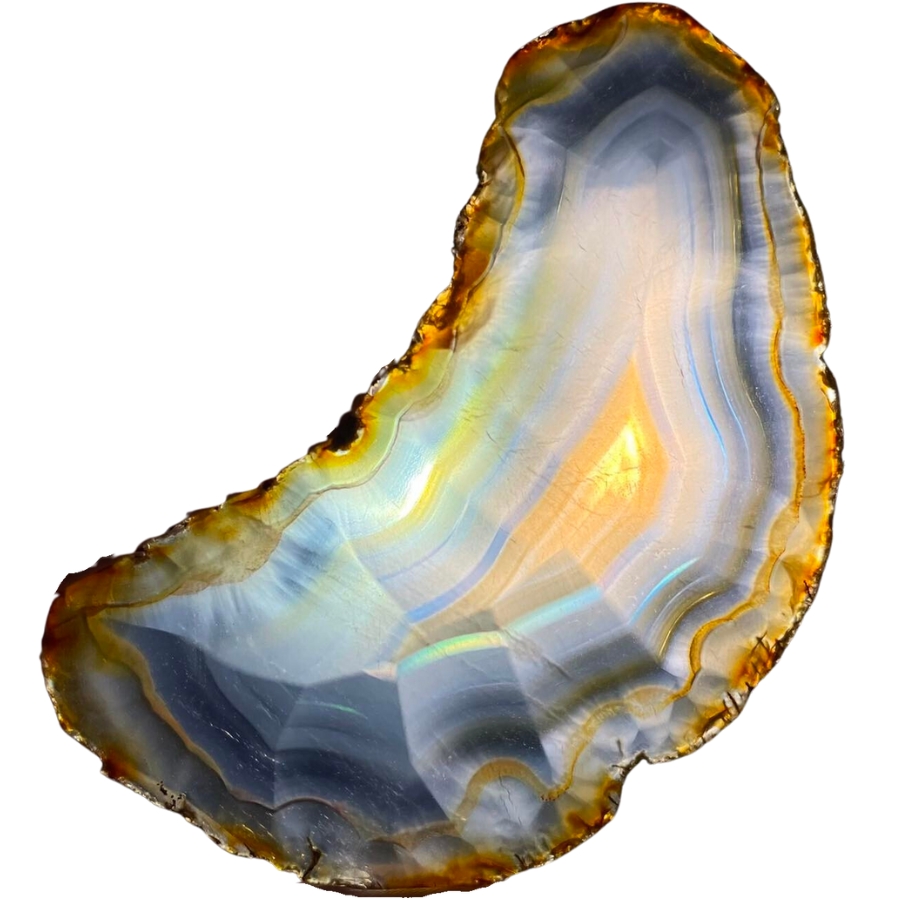
Iris agate looks like a regular agate at first, but when you hold it up to the light, something amazing happens. It shows all these rainbow colors, like light passing through a prism.
This is because it has very thin layers of silica, and when light hits these layers, it splits into all the colors of the rainbow.
The formation of iris agate is similar to other agates, but its layers are super thin, which is what creates the rainbow effect.
The value of iris agate comes from its unique ability to show these colors. In the past, people even used to think it had magical properties because of the way it showed colors. They saw it as a stone of good luck and wonder.
Where you can find iris agate
You can find iris agate in the USA, especially in states like Montana, Oregon, and Idaho. They have the perfect combination of volcanic history and the right kind of rocks that make it possible for it to form.
Outside the USA, countries like Brazil and Mexico also have beautiful iris agates.
Plume Agate
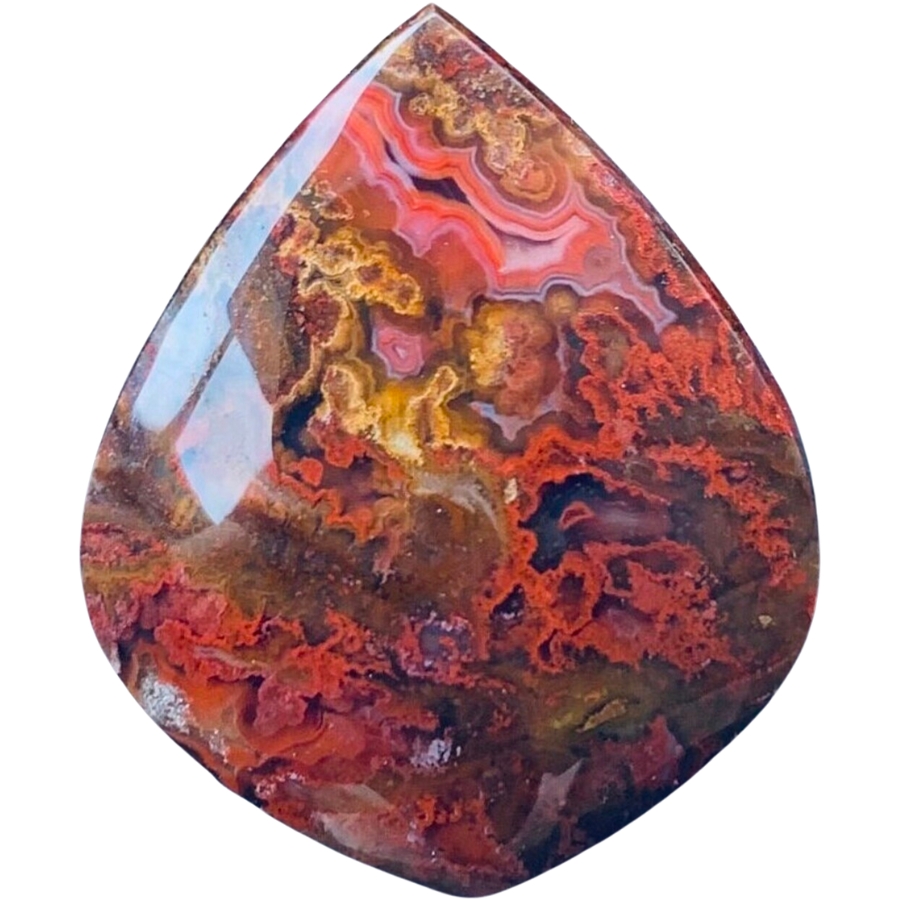
Plume agate gets its name from its patterns that look like soft, feathery plumes. These plumes can be in all sorts of colors: red, black, green, or yellow, set against a translucent or opaque background.
The way these plumes seem to float in the stone makes it look like a frozen underwater scene or like feathers caught in a breeze.
The plumes are made of minerals like manganese or iron oxide, which get trapped in the silica during the agate’s formation and create the feathery patterns.
The price of plume agate can vary depending on how clear and intricate the patterns are. The more detailed and colorful the plumes, the more the stone is usually worth.
Where you can find plume agate
Plume agate is found in places like Oregon, Texas, and Idaho in the USA. As for outside th ecounty, they can be found in Mexico and Brazil. Each location gives plume agate its own special touch, making every piece unique.
Picture Agate (Scenic Agate)
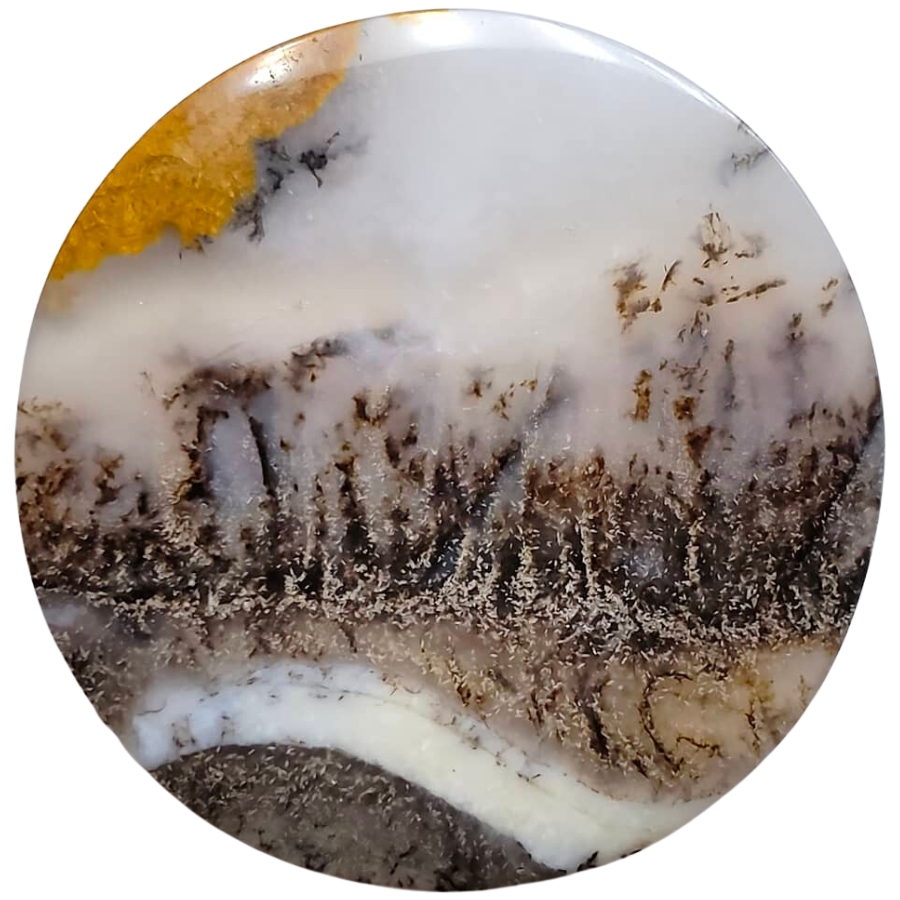
Picture agate is like a snapshot of nature captured in stone because it looks like it has pictures or scenes right inside it.
These “pictures” are actually natural patterns that resemble landscapes, mountains, trees, or even skies. They are usually in different shades of brown, white, and gray against a more translucent background.
The different patterns in picture agate or what’s also called scenic agate are made by various minerals in the water filled with silica that forms it.
If you’re thinking, “What is picture agate worth?“, its value comes from how distinct, clear, and detailed the natural “pictures” are.
Where you can find picture agate (scenic agate)
If you want to find picture agate, you can explore Oregon and Arizona where they were reported to be found.
Outside the USA, countries like Brazil and India are also known for their picture agates.
Turritella Agate
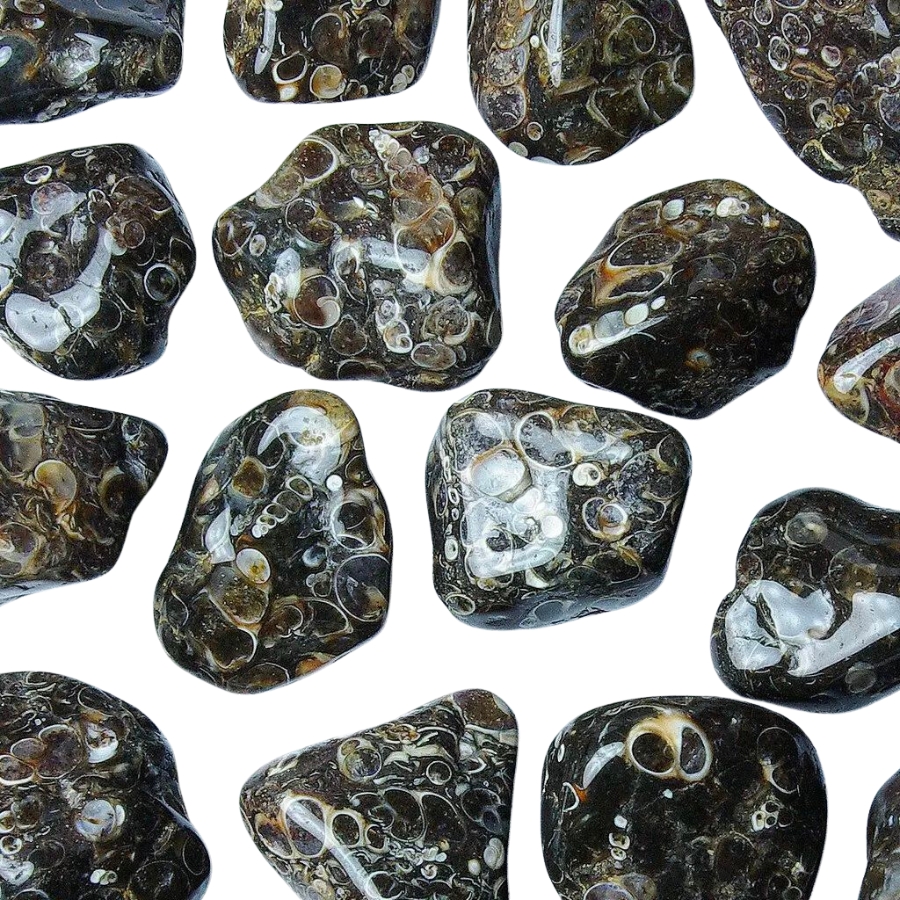
Turritella agate is not your typical agate because it’s full of fossilized snail shells! The shells belong to a creature called Turritella, a type of sea snail.
These shells are tightly packed and create a pattern that looks like a bunch of tiny, swirling towers. The background of the agate is usually a dark, earthy color, which makes the white or cream-colored snail shells really pop.
Over millions of years, these snail shells got buried in sediment and eventually became fossilized. As time went on, silica-rich water flowed through the sediment, turning it into the agate we see today.
The value of turritella agate comes from its unique blend of geology and history. More than a pretty stone, it’s a piece of ancient life preserved in rock.
Where you can find turritella agate
Turritella agate has some specific places where it’s commonly found, especially in areas with a rich history of ancient sea life. In the USA, Wyoming is a prime spot for finding it.
Lake Superior Agate
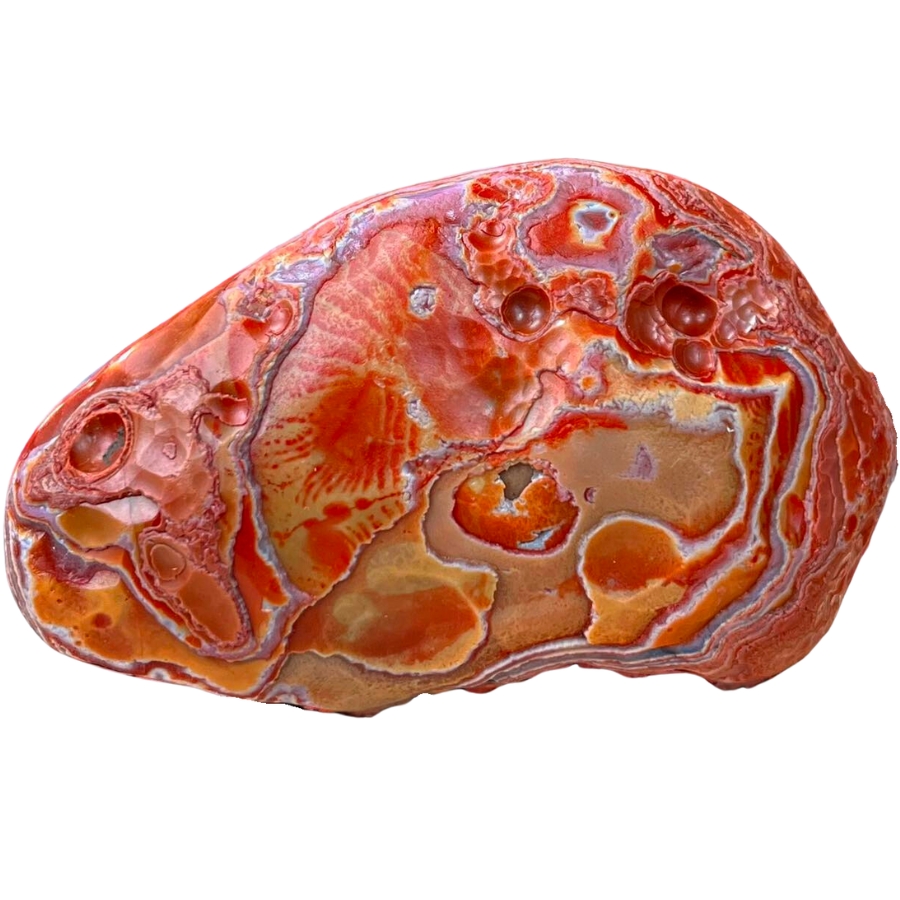
Picture bands of red, orange, yellow, and sometimes even blue and green, all swirling together— that’s Lake Superior agate for you!
These bands are made of different minerals, which give it its wide range of colors. Its colors can be really bright or more subdued, but they’re always eye-catching.
Lake Superior agate stands out because of its rich colors and patterns. It’s often used in jewelry and decorative items, where its colors can really shine.
It’s actually the state gemstone of Minnesota! It’s a local treasure that captures the beauty and history of the region.
Where you can find Lake Superior agate
Lake Superior agates are mainly found around the Lake Superior area in Minnesota, Michigan, and Wisconsin, USA. They’re often discovered in riverbeds, on beaches, or even in fields.
These places were once covered by massive glaciers. When the glaciers moved, they left behind lots of rocks, including Lake Superior agates.
Fairburn Agate
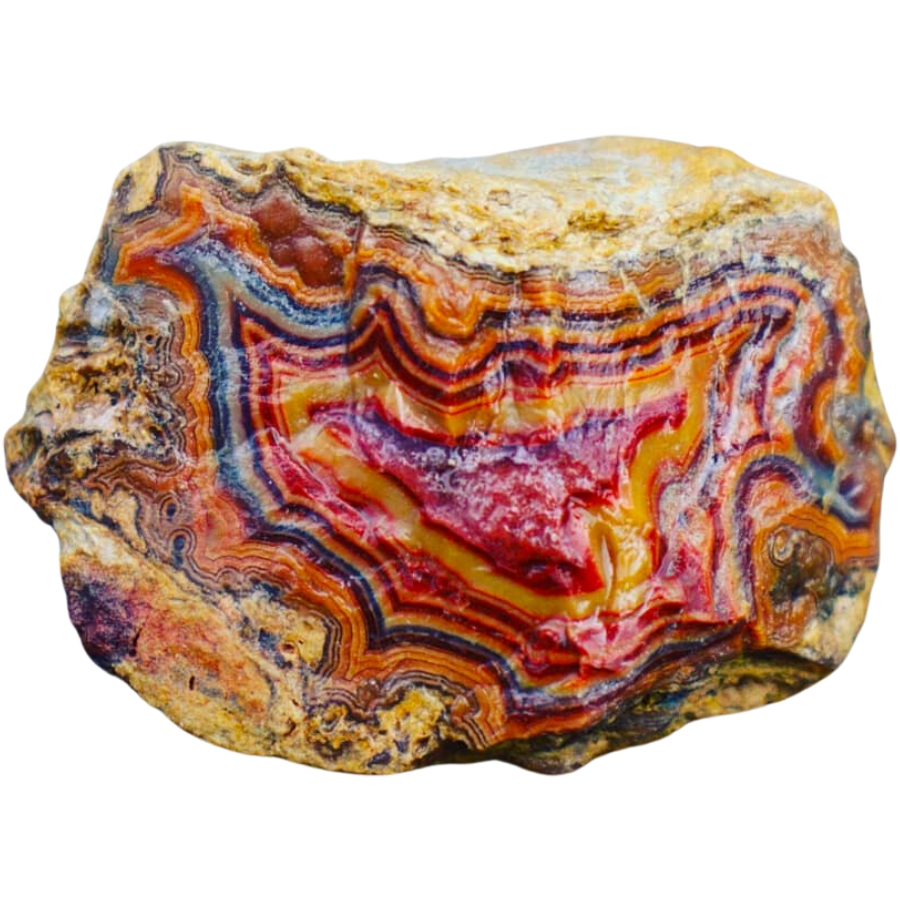
Known for its intricate patterns and bold colors, Fairburn agate is another fascinating type of agate. It usually has bands and swirls of different colors like red, yellow, orange, brown, and sometimes even pink or purple.
What’s special about these patterns is they often look like they’re in layers, creating a 3D effect. It’s like looking at a landscape made of stone.
It’s named after a place called Fairburn in South Dakota. This gives a clue about where it was first discovered.
People value Fairburn agate for the skill it takes to cut and polish it, which makes the patterns and colors really stand out.
Where you can find Fairburn agate
Fairburn Agate is mostly found in the USA, especially in South Dakota. It’s named after a town called Fairburn. This area, along with the nearby Black Hills region, is known for having lots of these special agates.
The places where Fairburn Agate grows are pretty cool. They’re often found in old riverbeds and eroded hillsides.
Sagenite Agate
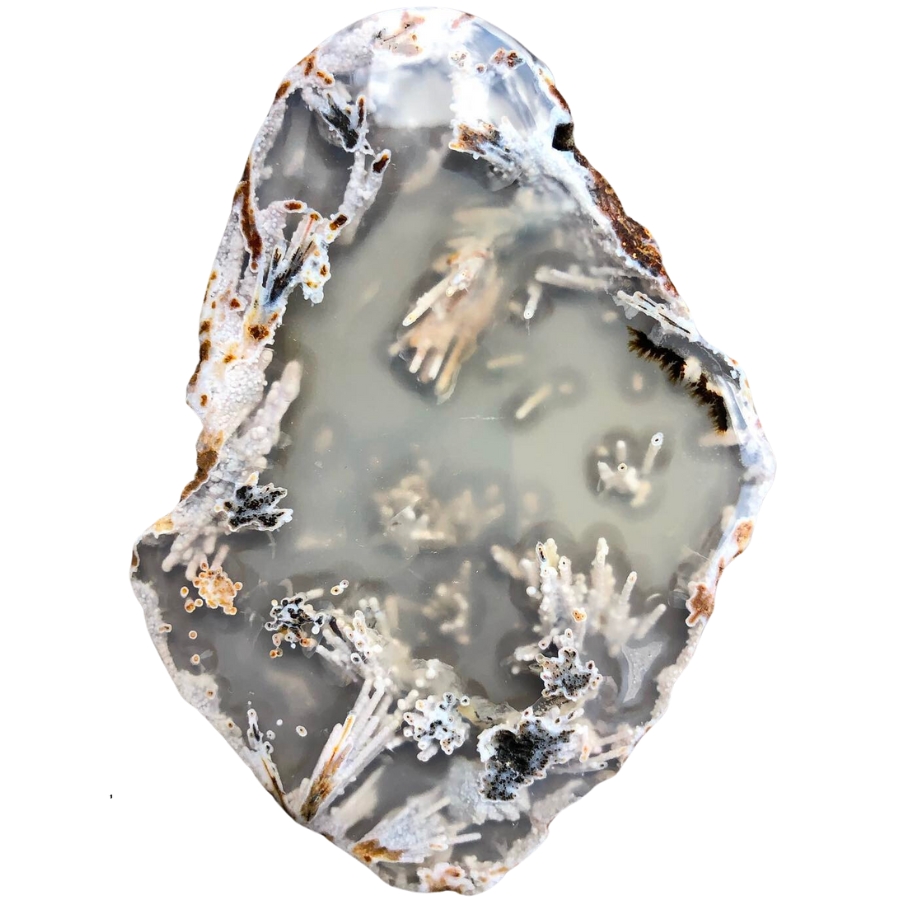
Sagenite agate has needle-like inclusions that look like tiny sprays of crystals inside it. They can be gold, silver, black, or even green, and they spread out in all directions, creating an amazing pattern.
The base of the agate is usually translucent, which lets you see these intricate needle patterns clearly.
These patterns are actually other minerals, like rutile or goethite, that get trapped inside the forming agate. These minerals grow in a crystal shape, looking like needles or hair.
Sagenite agate is often used in jewelry and other decorative items, with some people thinking that its needle patterns look like fireworks or starbursts.
Where you can find sagenite agate
You can find amazing pieces of sagenite agate in California, Arizona, and Michigan in the USA. Countries like Mexico and Brazil are also known for their sagenite agates.
Tree Agate
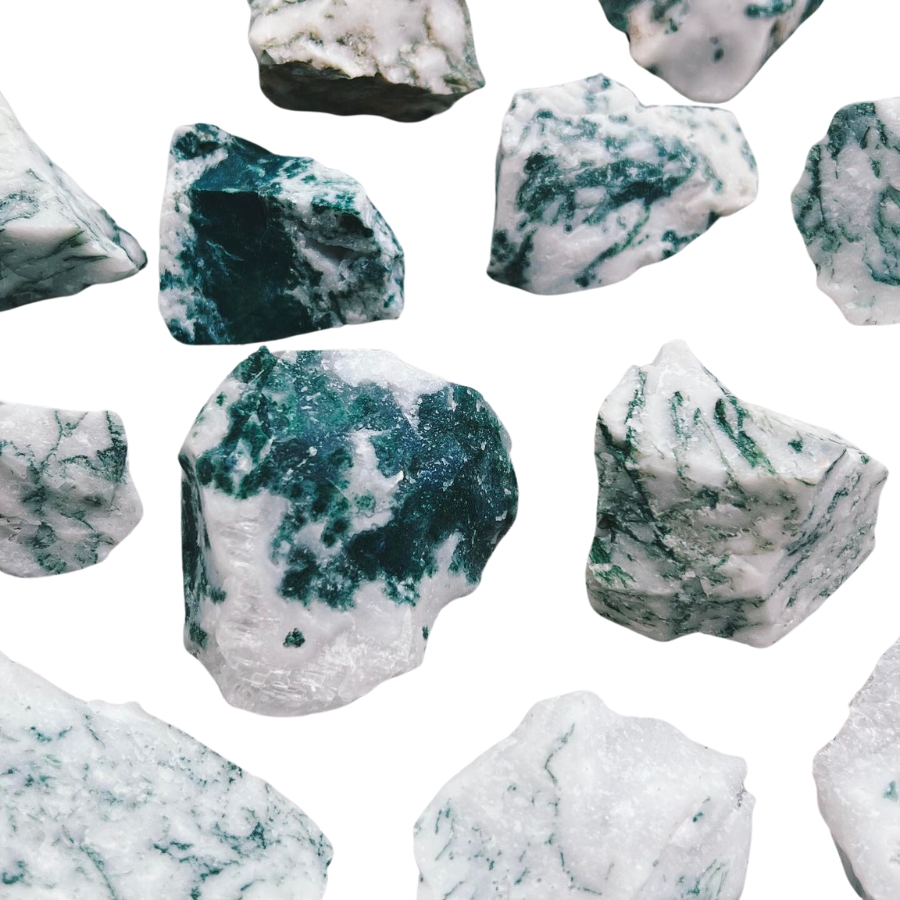
Tree agate, as its name suggests, looks like it’s got tiny trees or branches inside it. These tree-like patterns are usually green and spread out against a white or light gray background.
The green patterns aren’t actual trees, though. They’re made of minerals like chlorite or manganese.
Each piece of tree agate is different. You won’t find two that are exactly the same. It’s valued for its looks and it’s often used in jewelry and decorations.
Some people believe that it can also bring a sense of peace and connection to nature.
Where you can find tree agate
You can explore the areas of Arizona and New Mexico if you’re eyeing to find tree agate in the USA. Just remember, they grow best in areas with volcanic rocks.
You can also find beautiful pieces of tree agates in India and Brazil.
Eye Agate
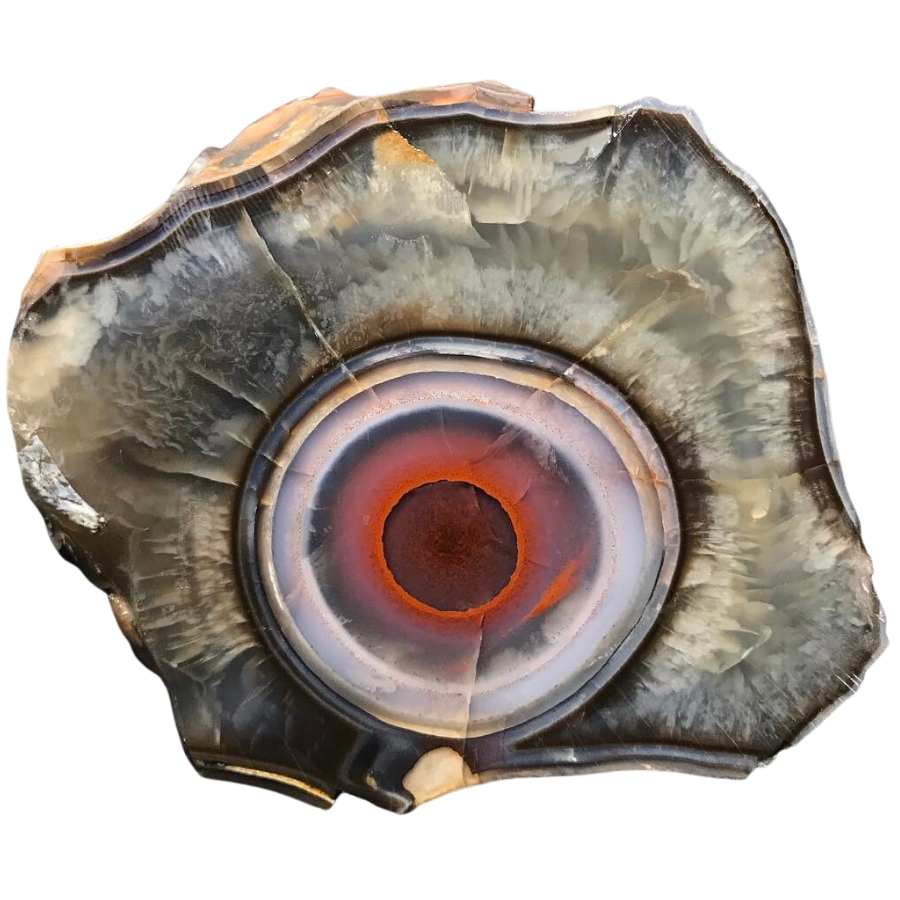
Eye agate is called as such because it looks like it has eyes! Its patterns create shapes that look a lot like eyes, with concentric circles or ovals.
These “eyes” can be in various colors, set against a contrasting background, which makes them stand out. The colors and number of eyes can vary a lot, making each piece unique.
The eye patterns in this agate happen when the silica is layered in a circular pattern, like rings in a tree.
There’s no denying that eye agate is one that catches your eye (pun intended)! In some cultures, people think it’s a lucky stone. They believe it can protect you from bad things and bring good luck.
Where you can find eye agate
In the USA, you can find interesting pieces of eye agate in states like Oregon, Washington, and Michigan. Other countries like India, Brazil, and Uruguay are also known for their eye agate.
These places have the perfect mix of rocks and mineral content needed for the formation of this type of agate.
Thunder Egg Agate
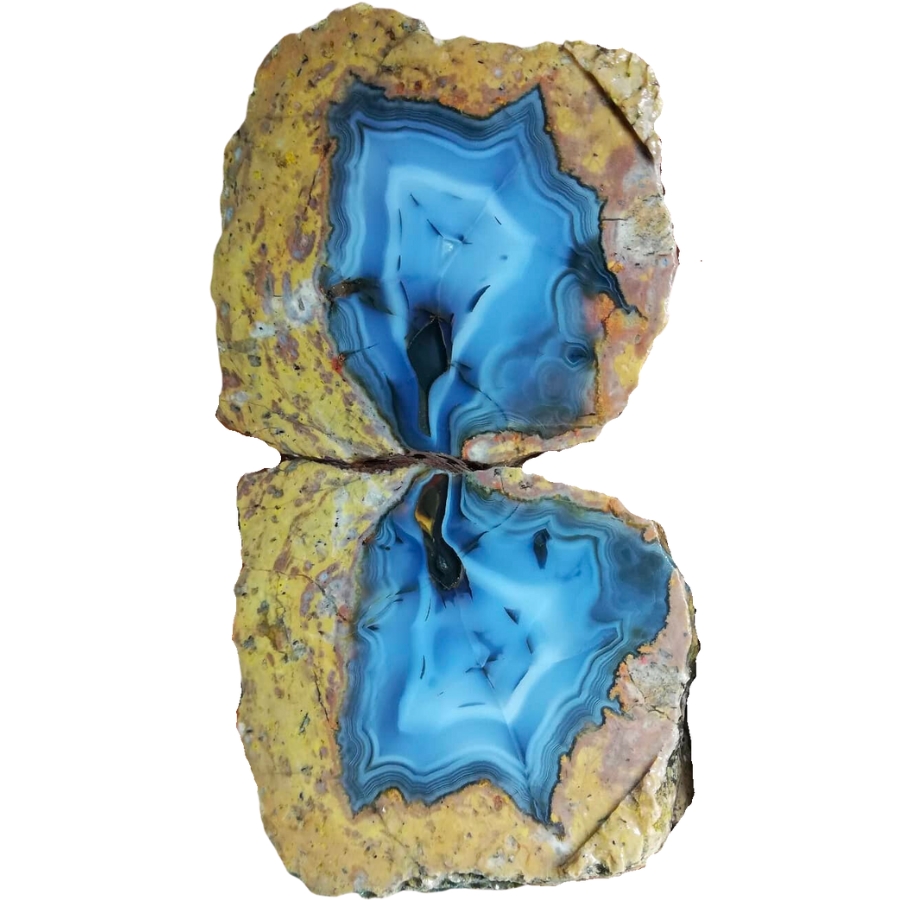
Thunder egg agate looks like a plain, rough stone on the outside. But when you cut it open, it’s a whole different story.
Inside, you’ll find beautiful patterns and colors. Some have bands of agate or rings of quartz, and others might have sparkling crystals in the center. The colors can range from blues and greens to reds and yellows.
These rocks start as bubbles in volcanic ash. Over time, minerals like silica fill these bubbles. The silica hardens into agate or other types of quartz, creating the amazing patterns inside the thunder egg.
From the outside, you’d never guess how beautiful they are on the inside. The name “Thunder Egg” comes from a Native American legend. They believed these stones were thrown by angry thunder spirits on mountaintops.
Where you can find thunder egg agate
One of the best spots to find thunder egg agates in the USA is in Oregon. In fact, Oregon loves these rocks so much that they even made the thunder egg their official state rock!
Other states like Arizona, New Mexico, and California are also known for having thunder egg agates.
Enhydro Agate
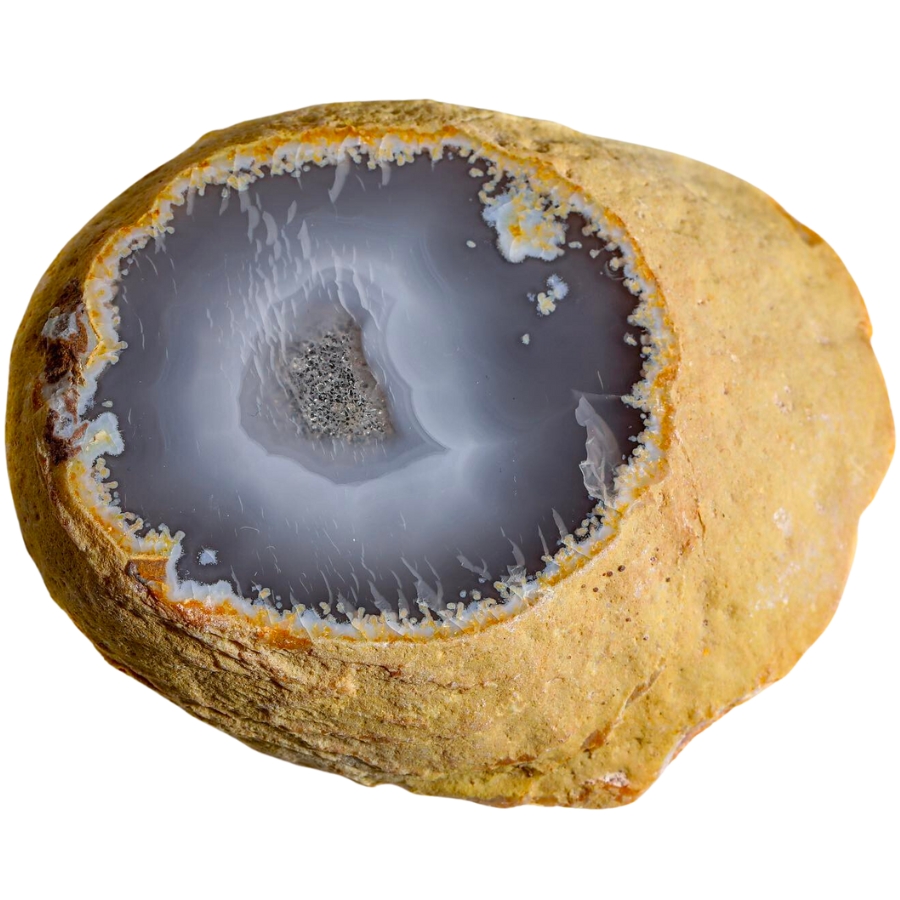
Enhydro agate looks like a regular agate on the outside, with bands of different colors. But the coolest part is inside.
Some enhydro agates have little pockets of water trapped inside them! That’s right, water that’s been stuck in there for millions of years.
This agate forms just like other agates, with a little bit of the water that got trapped inside. As the agate forms around it, this water becomes a tiny time capsule.
It’s not every day you find a rock with ancient water in it, so people are amazed by the idea of holding a piece of history in their hands.
Some even believe that the water inside enhydro agate has special properties since it’s been untouched for so long.
Where you can find enhydro agate
To find enhydro agate, you can visit and explore places like Montana, Oregon, and Idaho. These states have areas with the right kind of volcanic rocks where these agates can form.
Polyhedroid Agate
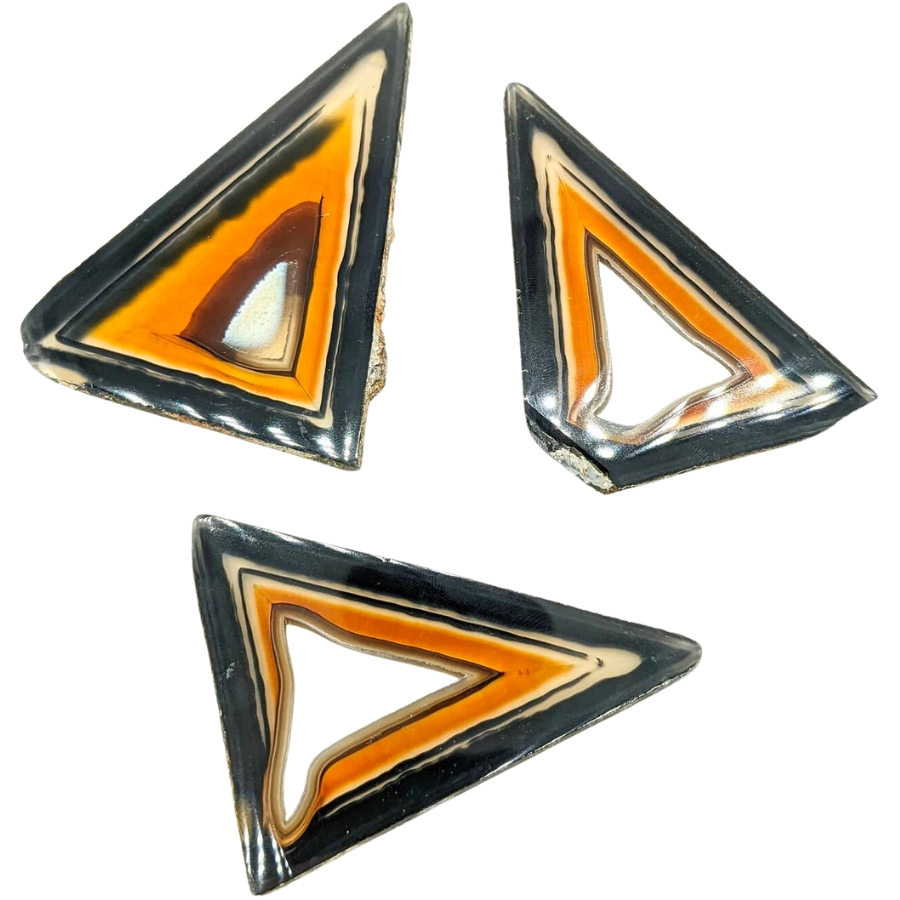
Polyhedroid agate is different from other agates because of its shape and patterns. Instead of the usual round or oval shapes, it forms in angular, flat-sided shapes, like little polyhedrons.
The patterns inside these stones are also super cool. They often have sharp, straight lines and geometric patterns, which is quite different from the wavy or circular patterns you see in other agates.
The formation of polyhedroid agate is a bit of a mystery, but geologists think it has to do with how the silica-rich water flowed and cooled inside the rock cavities.
Polyhedroid Agate is valued for its rarity and its unusual appearance. It’s not a common type of agate, so finding one is pretty exciting for rock collectors.
Where you can find polyhedroid agate
Polyhedroid Agate is a rare find, and it’s not commonly found in many places. One of the few known locations for this unique agate is in Brazil. In the USA, however, it’s not such a common find.
Coyamito Agate
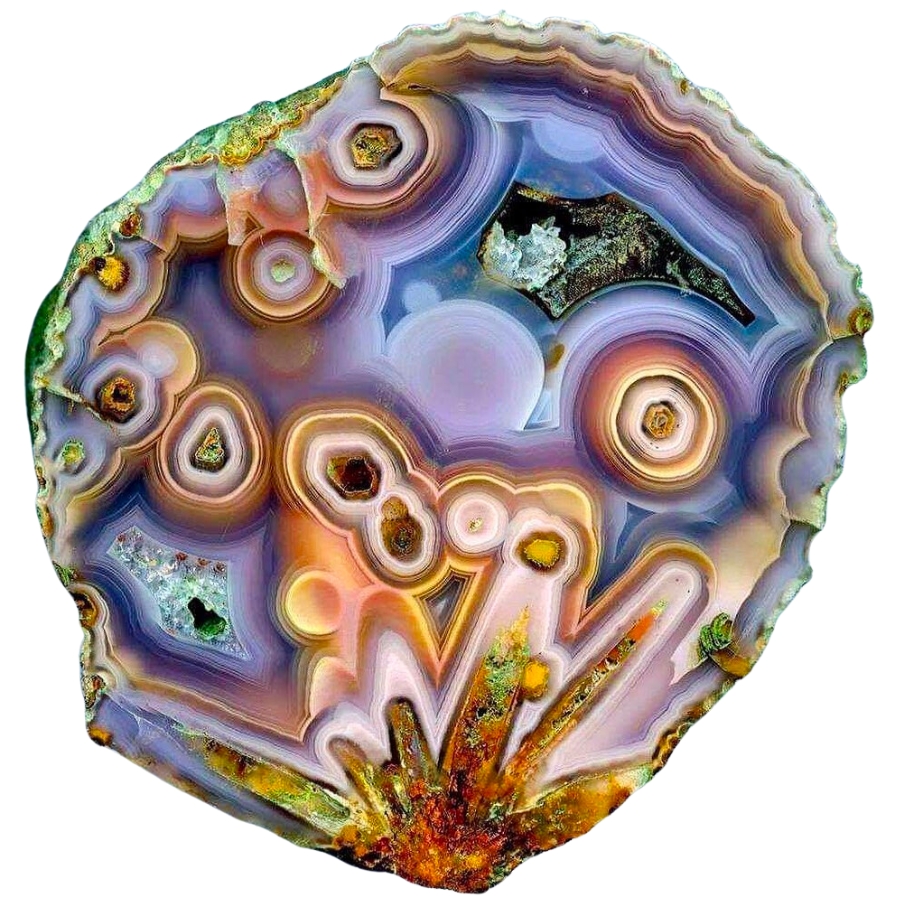
Coyamito agate has vivid colors and intricate patterns. Its colors can range from bright reds and oranges to purples and yellows, and they often have really cool, swirling patterns.
Some Coyamito agates even have what looks like a “floating” layer inside them, which is pretty unique.
Its vibrant colors and the complexity of its patterns set Coyamito agate apart.
It’s often found in smaller sizes compared to other agates, but what it lacks in size, it makes up for in beauty and color.
Where you can find Coyamito agate
Coyamito agate has a pretty specific home: it’s mainly found near the Coyamito Ranch in Chihuahua, Mexico. Its volcanic history is a big part of why Coyamito agates are so unique.

